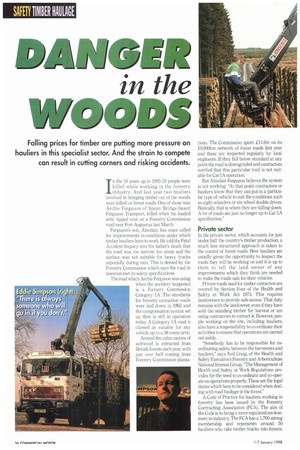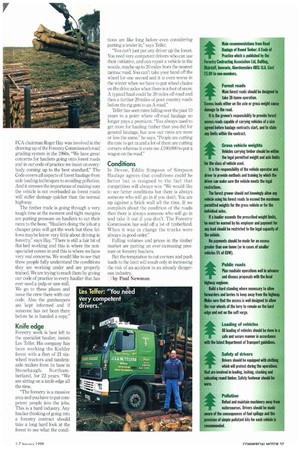DANGER
Page 38

Page 39

If you've noticed an error in this article please click here to report it so we can fix it.
in the
WOODS
Falling prices for timber are putting more pressure on hauliers in this specialist sector. And the strain to compete can result in cutting corners and risking accidents.
In the lo years up to 1995 52 people were killed while working in the forestry industry. And last year two hauliers involved in bringing timber out of the woods were killed on forest roads. One of those was Archie Ferguson of Spean Bridge-based Ferguson Transport, killed when his loaded artic tipped over on a Forestry Commission road near Fort Augustus last March.
Ferguson's son, Aiasdair, has since called for improvements in conditions under which timber hauliers have to work. He told the Fatal Accident Inquiry into his father's death that the road was too narrow, too steep and the surface was not suitable for heavy trucks especially during rain. This is denied by the Forestry Commission which says the road in question met its safety specifications.
The road which Archie Ferguson was using when the accident happened is a Forestry Commission Category 1A. The standards for forestry extraction roads were laid down in 1962 and the categorisation system set up then is still in operation today A Category 1A road is classed as suitable for any vehicle up to a 38-tonne artic.
Around 8m cubic metres of softwood is extracted from British forests each year, with just over half coming from Forestry Commission planta tions. The Commission spent L11.6m on its 10,000km network of forest roads last year and these are inspected regularly by local engineers. If they fall below standard at any point the road is downgraded and contractors notified that this particular road is not suitable for Cat 1A operation.
But Alasdair Ferguson believes the system is not working: "At that point contractors or hauliers know that they can put in a particular type of vehicle to suit the conditions such as eight-wheelers or six-wheel double drives. Basically, that is where they are falling down. A lot of roads are just no longer up to Cat 1A specification."
Private sedor
In the private sector, which accounts for just under half the country's timber production, a much less structured approach is taken to the control of forest roads. Here hauliers are usually given the opportunity to inspect the roads they will be working on and it is up to them to tell the land owner of any improvements which they think are needed to make the roads safe for their vehicles.
Private roads used for timber extraction are covered by Section Four of the Health and Safety at Work Act 1974. This requires landowners to provide safe access. That duty remains with the landowner, even if they have sold the standing timber for harvest or are using contractors to extract it. However, people working on the site, including hauliers, also have a responsibility to co-ordinate their activities to ensure that operations are carried out safely.
"Somebody has to be responsible for coordinating safety between the harvesters and hauliers," says Neil Craig, of the Health and Safety Executive's Forestry and Arboriculture National Interest Group. "The Management of Health and Safety at Work Regulations provides for the need to co-ordinate and co-operate on operations properly. These are the legal duties which have to be considered when dealing with road haulage in the forest."
A Code of Practice for hauliers working in forestry has been issued by the Forestry Contracting Association (FCA). The aim of the Code is to bring a more regulated environment to industry, The FCA has a 1,700-strong membership and represents around 50 hauliers who take timber trucks into forests.
FCA chairman Roger Hay was involved in the drawing up of the Forestry Commission's road grading system in the 1960s. "We have great concerns for hauliers going onto forest roads and in our code of practice we insist on everybody coming up to the best standard." The Code covers all aspects of forest haulage from safe loading techniques to avoiding pollution. And it stresses the importance of making sure the vehicle is not overloaded as forest roads will suffer damage quicker than the normal highway The timber trade is going through a very tough time at the moment and tight margins are putting pressure on hauliers to cut their rates to the bone. "Hauliers doing the job at a cheaper price will get the work but these fellows maybe know very little about driving in forestry," says Hay. "There is still a fair bit of flat-bed working and this is where the nonspecialist comes in and this is where we have very real concerns, We would like to see that these people fully understand the conditions they are working under and are properly trained, We are trying to reach them by giving our code of practice to every haulier that has ever used a pulp or saw mill. We go to these places and issue the crew there with our code. Also the gatekeepers are kept informed and if someone has not been there before he is handed a copy."
Knife edge
Forestry work is best left to the specialist haulier, insists Les Telfer, His company has been working the Kielder forest with a fleet of 21 six. wheel tractors and tandemaxle trailers from its base in Stonehaugh, Northumberland, for 22 years. "We are sitting on a knife edge all the time.
"The forestry is a massive area and you have to put competent people into the jobs. This is a hard industry. Any haulier thinking of going into a forestry contract should take a long hard look at the forest to see what the condi
tions are like long before even considering putting a tender in," says Teller.
"You can't just put any driver up the forest. You need very competent drivers who can use their initiative, and can repair a vehicle in the woods, maybe up to 20 miles from the nearest tarmac road. You can't take your hand off the wheel far one second and it is even worse in the winter when we have to put wheel chains on the drive axles when there is a foot of snow A typical haul could be 20 miles off-road and then a further 20 miles of poor country roads before the rig gets to an A-road."
Telifer has seen rates falling over the past 10 years to a point where off-road haulage no longer pays a premium. "You always used to get more for hauling timber than you did for general haulage, but now our rates are more or less the same." he says. "People are cutting the rate to get in and a lot of them are cutting corners whereas it costs me .J.:100,000 to put a wagon on the road."
Conditions
In Devon, Eddie Simpson of Simpson Haulage agrees that conditions could be better but is resigned to the fact that competition will always win: "We would like to see better conditions but there is always someone who will go in if you don't. You are up against a brick wall all the time. If we complain about the condition of the roads then there is always someone who will go in and take it out if you don't. The Forestry Commission has sold off a lot of timberland. When it was in charge the tracks were always in good order."
Falling volumes and prices in the timber market are putting an ever-increasing pressure on forestry hauliers.
But the temptation to cut corners and push loads to the limit will result only in increasing the risk of an accident in an already dangerous industry.
71 by Paul Newman
Ma ressumendalions from Road • Haulage of Round limber. A Code of Practice ilia is published by the Costradig Association Ltd, Daiffrg, , horenwie, Aberdeenshire AM RA cod. to wominembers.
Forest roads Main forest roads should be designed to take 38-tonne operation.
Excess loads either on the axle or gross weight cause damage to the road.
ft is the grower's responsibility to provide forest access roads capable of carrying vehicles of a size agreed before haulage contracts start, and to state any limits within the contract.
Gross vehicle weights
Vehicles carrying timber should be within the legal permitted weight and axle limits for the class of vehicle used.
It is the responsibility of the vehicle operator and driver to provide methods and training by which the driver can make sure the vehicle meets the legal restrictions.
The forest grower should not knowingly allow any vehicle using his forest roans to exceed the maximum permitted weights for the gross vehicle or for the individual axles.
If a haulier exceeds the prescribed weight limits, he must he warned by his employer and payment for any load should be restricted to the legal capacity of the vehicle.
No payments should be made for an excess greater than one tonne (or in cases of smaller vehicles 57, of CVW).
Public roads
Plan roadside operations well in advance and discuss proposals with the local highway engineer.
Build a hard standing where necessary to allow forwarders and lorries to beep away from the highway. Make sure that the access is well designed to allow the rear wheels of the lorry to remain on the hard edge and not on the soft verge.
Loading of vehicles
All loading of vehicles should be done in a safe and secure manner in accordance with the latest Department of Transport guidelines.
Safety of drivers
Drivers should be equipped with clothing which will protect during the operations that are involved in loading, lashing, stacking and unloading round timber. Safety footwear should be worn.
Pollution
Refuel and maintain machinery away from watercourses. Drivers should be made aware of the consequences of fuel spillage and the provision of simple pollutant kits for each vehicle is recommended.
















































































